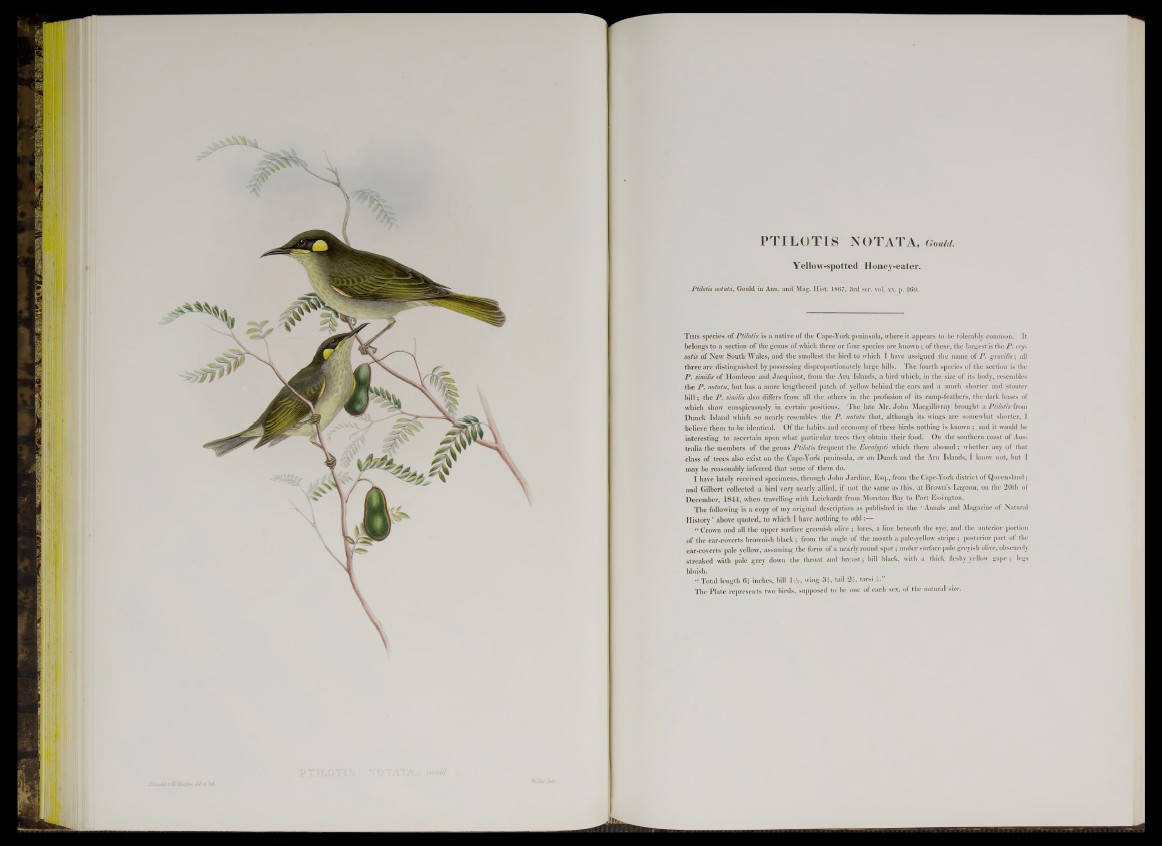
PTILOTIS NOTATA, Gould.
Yellow-spotted Honey-eater.
Ptilotis notata, Gould in Ann. and Mag. Hist. 1867, 3rd ser. vol. xx. p. 269.
T h is species of Ptilotis is a native of the Cape-York peninsula, where it appears to be tolerably common. It
belongs to a section of the genus of which three or four species are known ; of these, the largest is the P. cry-
sotis of New South Wales, and the smallest the bird to which I have assigned the name of P. gracilis; all
three are distinguished by possessing disproportionately large bills. The fourth species of the section is the
P . similis of Hombron and Jacquinot, from the Aru Islands, a bird which, in the size of its body, resembles
the P. notata, but has a more lengthened patch of yellow behind the ears and a much shorter and stouter
b ill; the P. similis also differs from all the others in the profusion of its rump-feathers, the dark bases of
which show conspicuously in certain positions. The late Mr. John Macgillivray brought a Ptilotis from
Dunck Island which so nearly resembles the P. notata that, although its wings are somewhat shorter, I
believe them to be identical. Of the habits and economy of these birds nothing is known ; and it would be
interesting to ascertain upon what particular trees they obtain their food. On the southern coast of Australia
the members of the genus Ptilotis frequent the Eucalypti which there abound ; whether any of that
class of trees also exist on the Cape-York peninsula, or on Dunck and the Aru Islands, I know not, but I
may be reasonably inferred that some of them do.
I have lately received specimens, through John Jardine, Esq., from the Cape-York district of Queensland ;
and Gilbert collected a bird very nearly allied, if not the same as this, at Brown’s Lagoon, on the 20th of
December, 1844, when travelling with Leichardt from Moreton Bay to Port Essington.
The following is a copy of my original description as published in the ‘ Annals and Magazine of Natural
History ’ above quoted, to which I have nothing to add :—
« Crown and all the upper surface greenish olive; lores, a line beneath the eye, and the anterior portion
of the ear-coverts brownish black; from the angle of the mouth a pale-yellow strip e; posterior part of the
ear-coverts pale yellow, assuming the form of a nearly round sp o t; under surface pale greyish olive, obscurely
streaked with pale grey down the throat and breast; bill black, with a thick fleshy yellow g ap e ; legs
bluish.
“ Total length 6 | inches, bill ItVj wing 38-, tail 2£, tarsi £.”
The Plate represents two birds, supposed to be one of each sex, of the natural size.